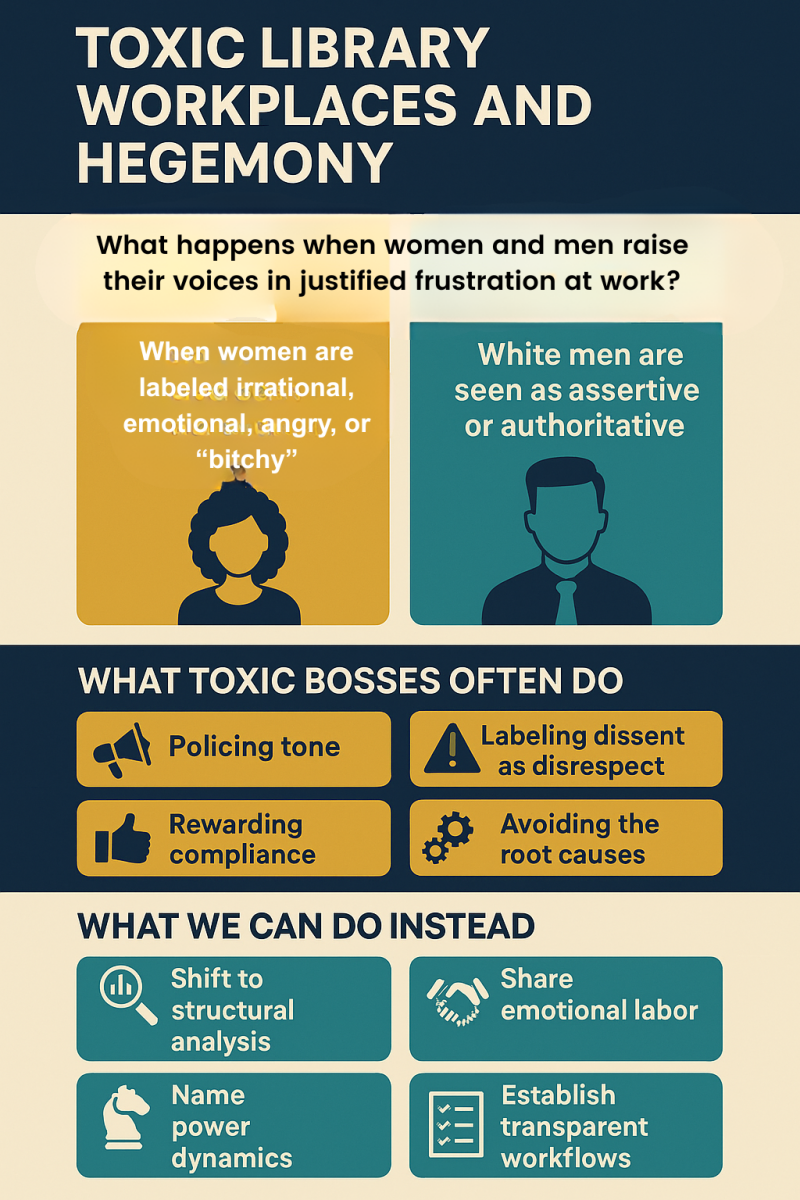I still remember sitting in my office—the one with the flickering fluorescent bulb that no one ever seemed to get around to fixing—listening to a colleague recount how she’d been labeled “too emotional” in a meeting. She had pushed back calmly, firmly, and professionally against an unreasonable new directive; yet somehow, the focus shifted not to the directive but to her tone.
I had heard versions of this story before. In libraries—like in many workplaces—reactions are often policed more heavily than the inequity that caused them.
So when I read the highlighted passage from Kari Grain’s Seven Principles of Critical Hope, it felt like she had been sitting in the staff lounge with us, taking notes.
Grain reminds us that hegemony works quietly. It shapes how “a Black woman in the workplace who raises her voice in frustration is liable to be labeled irrational, overly emotional, angry, or bitchy… as opposed to undergoing a structural analysis that examines what inequities are at play that led her to a justified feeling of frustration.” Meanwhile, a White man’s frustration is more likely to be interpreted as a sign of authority.
I reference Grain’s analysis here not to speak for Black women, but to highlight how her framework helps us interrogate power, emotion, and inequity in library workplaces.
That sentence hit with force because it explains something many of us in libraries feel daily but struggle to articulate:
In toxic environments, power determines whose emotions are valid.
And libraries—despite our mission of equity, knowledge, and care—are not exempt from these dynamics.
The Quiet Machinery of Hegemony in Libraries
Libraries pride themselves on neutrality and fairness, but the truth is that many library workplaces operate under invisible, longstanding power hierarchies:
- senior leaders vs. “frontline” workers
- directors vs. staff
- predominantly white leadership vs. diverse staff
- adjunct faculty vs. full-time staff
- long-tenured employees vs. new hires
Within these hierarchies, emotional reactions are not interpreted equally.
If a staff member from a marginalized group expresses frustration about inequitable workloads, inconsistent expectations, or lack of recognition, their reaction may be pathologized:
- “She’s too sensitive.”
- “He’s aggressive.”
- “They’re not a team player.”
But if a toxic boss—especially one with institutional power on their side—raises their voice, it is reframed as passion, urgency, or professionalism.
This imbalance is not accidental.
It is the result of hegemonic norms that shape how we see leadership, authority, and dissent.
How Toxic Bosses Use Hegemony to Maintain Control
In toxic library environments, hegemony becomes a tool.
A toxic boss doesn’t need to yell to exert dominance.
Often, they:
- subtly police tone
- weaponize “professionalism”
- reward compliance over critical thinking
- label dissent as disrespect
- use HR frameworks to silence the very people HR is supposed to protect
This is where Grain’s insight becomes vital:
When we individualize someone’s emotional response, we avoid examining the systems that produced the frustration in the first place.
It’s easier—for leaders, for institutions—to critique someone’s tone than to confront inequitable workloads, racial bias, or chronic understaffing.
Libraries often describe themselves as “family.”
But families can be dysfunctional too.
The Moment of Discomfort: A Turning Point Rather Than a Punishment
Grain writes that discomfort is a powerful teacher.
But in toxic workplaces, discomfort is used not for growth, but for control.
People are told to "self-regulate" instead of being asked why they’re struggling.
People are coached on composure instead of supervisors being coached on equity.
People are asked to attend training instead of leaders being asked to change.
To reclaim discomfort as a tool for hope—not harm—we need to use it to challenge the underlying structures.
A Path Forward: Five Solutions That Create Critical Hope in Library Workplaces
Here is where Grain’s “critical hope” becomes not just a concept but a practice.
1. Shift From Tone Policing to Structural Analysis
The next time someone expresses frustration, ask:
What conditions created this response?
Not How could they have said it better? but What is happening in the environment that made this reaction reasonable?
2. Create Shared Accountability for Emotional Labor
Emotional regulation cannot be the sole burden of marginalized staff.
Supervisors must model empathy, self-reflection, and openness to feedback—even when it stings.
3. Name Power When You See It
If leadership voices are always interpreted as authoritative and staff voices as emotional, call it out.
This is not incivility—it is honesty.
4. Establish Transparent Workflows and Expectations
Ambiguity breeds inequity.
When staff know what to expect, toxic bosses lose one of their most effective tools: arbitrary enforcement.
5. Build Spaces for Collective Reflection Free From Retaliation
Book clubs, discussion groups, and facilitated conversations using texts like Critical Hope offer staff a safer venue to explore inequity.
And when employees trust that they will not be punished for speaking the truth, the culture begins to shift.
The Heart of the Matter
The highlighted passage from Kari Grain tells a story about how people in marginalized positions are often punished not for what they say, but for daring to say anything at all.
In libraries—institutions literally dedicated to knowledge, justice, and freedom—that should disturb us deeply.
But Grain also points toward a future:
A future where discomfort becomes the doorway to structural clarity.
Where tone policing is replaced with accountability.
Where marginalized staff are believed the first time.
Where leadership learns to listen rather than discipline.
And where hope is not passive, but radical, critical, and shared.
Libraries can be places of liberation.
But only if the people who work within them are allowed to raise their voices without having their humanity questioned.
👉Inclusive Knowledge Solutions partners with academic libraries to build reflective, equity-driven, high-trust cultures. From leadership coaching to DEI strategy to learning design, we help librarians do their most courageous, collaborative work. Let’s connect.

Add comment
Comments